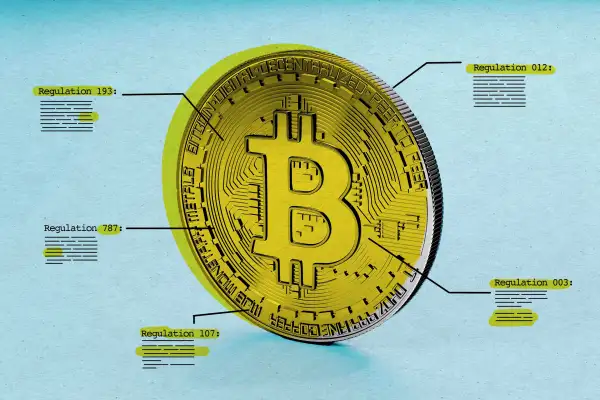Crypto Crackdown: Here’s What’s in Biden’s Plan for Regulations
Money is not a client of any investment adviser featured on this page. The information provided on this page is for educational purposes only and is not intended as investment advice. Money does not offer advisory services.

President Joe Biden is cracking down on crypto.
The White House released its first-ever comprehensive framework for "responsible development of digital assets" Friday following an executive order in March calling on regulators to assess the risks of digital currencies, develop policy recommendations and safeguard against the systemic financial risks that crypto poses.
The crypto market has grown massively over the last few years. According to the White House fact sheet, 16% of adult Americans have purchased digital assets. You can invest in crypto as easily as you can stocks, and even buy bitcoin, ether, dogecoin and others via Venmo or Paypal.
While digital assets "present potential opportunities to reinforce U.S. leadership in the global financial system and remain at the technological frontier," the White House says, they also "pose real risks as evidenced by recent events in crypto markets," referring to the crash of the stablecoin Terra in May.
The White House says that nine reports submitted to the president call on agencies to kickstart private-sector research and development and help "cutting-edge U.S. firms find footholds in global markets," while also mitigating risks.
"The reports encourage regulators, as they deem appropriate, to scale up investigations into digital asset market misconduct, redouble their enforcement efforts, and strengthen interagency coordination," Director of the National Economic Council Brian Deese and National Security Advisor Jake Sullivan said via a statement. "To accomplish all the above steps, the reports call for continued engagement with allies and partners on these issues, which will reinforce U.S. technological and financial leadership globally."
The crypto industry has long been awaiting more guidance from the government, especially since Biden's executive order in March. But the framework released today likely doesn't provide the explanations they wanted, since much of it calls for further exploration instead of actually addressing some major questions and concerns. For example, as CoinDesk points out, the framework doesn't answer "the single biggest U.S. question in crypto" — what actually makes a crypto token a security and which should be regulated as commodities.
The guidance essentially made clear something we already knew: The government sees a lot of risks with crypto. As Money has previously reported, experts say regulation could be good for investors, since it could increase crypto adoption, enhance security and spur innovation. But for now, the crypto world is still waiting on some key answers.
Crypto regulations framework: Biden's plan
From battling illicit finance to exploring a central bank digital currency, here are some of the key details in Biden's framework:
Protect individuals and businesses
The framework noted that "outright fraud, scams, and theft in digital asset markets are on the rise" and reported monetary losses from digital asset scams were nearly 600% higher in 2021 than in 2020. The administration says it plans to take several steps to promote protection, referencing concerns about the the high volatility in the crypto market and citing a 2018 Wall Street Journal report about disclosure and transparency issues of digital asset offerings.
These plans include "aggressively" pursuing investigations and enforcement against unlawful practices, redoubling efforts to monitor complaints and issuing guidance to address current and emergent risks.
Ensure financial stability
In a section of the framework about fostering financial stability, the White House references the potential for instability of stablecoins — cryptocurrencies with values pegged to another asset class, like the U.S. dollar — if they're not paired with regulation.
As next steps, the administration says the Treasury will work with financial institutions to enhance their ability to identify and mitigate cyber vulnerabilities and coordinate with agencies to analyze emerging risks.
Fight illicit finance
Crypto critics say the decentralized nature of digital assets make them ideal for criminals. The White House says digital assets have facilitated the rise of ransomware criminals and money laundering, for example.
The administration aims to fight crypto's use in illicit finance. The framework says the president will "evaluate whether to call upon Congress to amend the Bank Secrecy Act (BSA), anti-tip-off statutes, and laws against unlicensed money transmitting to apply explicitly to digital asset service providers — including digital asset exchanges and nonfungible token (NFT) platforms." He will also urge Congress to raise the penalties for these unlicensed money transmissions.
Biden also called on the Treasury to complete an assessment of the decentralized finance space regarding illicit finance by the end of February 2023 and an assessment of NFTs by July 2023.
Explore a new digital dollar
Finally, Biden's framework says a U.S. central bank digital currency (CBDC) — a.k.a. a digital dollar — could "enable a payment system that is more efficient, provides a foundation for further technological innovation, facilitates faster cross-border transactions, and is environmentally sustainable." The White House says an official digital dollar could also promote financial inclusion, protect against cyber risks and limit risks of illicit financial transactions.
During a congressional hearing last year, Federal Reserve chair Jerome Powell said that if the U.S. launched its own central bank digital currency, Americans wouldn't need crypto.
“You wouldn’t need stablecoins; you wouldn’t need cryptocurrencies, if you had a digital U.S. currency,” Powell said at the time. “I think that’s one of the stronger arguments in its favor.”
According to the framework, the administration has developed policy objectives for a U.S. CBDC System, but more research on the technology that would support it is needed.
"To support the Federal Reserve’s efforts and to advance other work on a potential U.S. CBDC, the Treasury will lead an interagency working group to consider the potential implications of a U.S. CBDC, leverage cross-government technical expertise, and share information with partners," the framework concluded.
